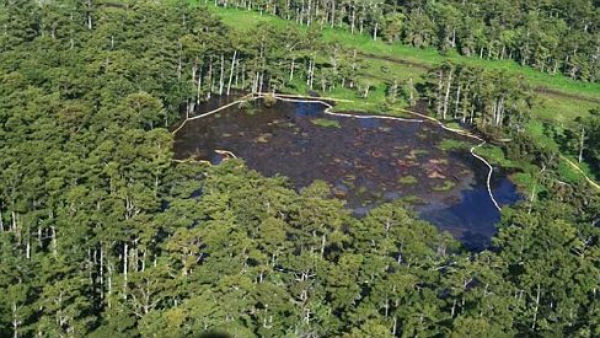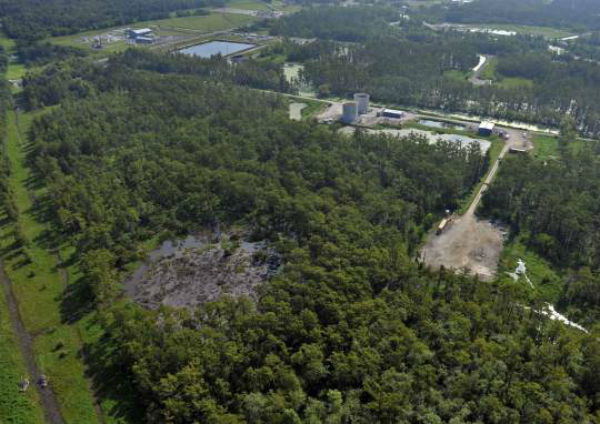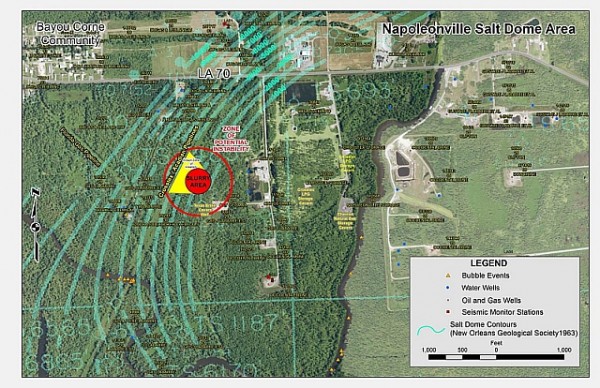Louisiana sinkhole – fears of radioactivity and gas explosion as sinkhole gets bigger

Boiling bubbles in the waters of Bayou Corne, in Assumption Parish, about 50 miles south of Baton Rouge in Louisiana, US, concerned residents in mid-May. Then, suddenly a massive sinkhole appeared on August 3. It forced the closure of nearby highway 70 after a gas line along that route bent and led to fears of an explosion. Officials believe the sinkhole could give off radiation or cause explosions that would harm local residents. Nearly 150 residences were asked to evacuate their homes on August 13 after the sinkhole swallowed nearby trees. Assumption Parish Police Jury continues monitoring Bayou Corne and Grand Bayou waterway bubbles.

Dr. Madhurendu Kumar, DNR director of the state’s oil and gas division, said the sinkhole could have been caused by structural problems in Texas Brine’s salt dome beneath it. Salt cavern is part of Napoleonville salt dome – a massive ancient structure that Texas Brine Company mines for use with mining petroleum, salt and sulphur. Texas Brine has mined the salt dome since 1973 for brine used by industry, using water to wash out salt deep in the dome and selling the resulting brine mix, company and DNR officials have said. DNR has ordered the Texas Brine Company to drill a well and see if it is the cause of the dark gray water-filled hole nearby. It will take at least 40 days to drill the well.
The potentially failed cavern may also be the source of natural gas that has bubbled up on nearby bayous and from an abandoned water well, emergency preparedness officials said. Texas Brine and other salt dome operators use salt-dome cavities left behind from mining operations to store hydrocarbons such as natural gas for companies that lease the wells. Texas Brine ceased operating the cavern in 2011 and plugged and abandoned the well used to access it, state officials said.

The 1.5 million barrels of liquid butane well and fear of radioactivity
The sinkhole could breach a nearby
There is a well close to the sinkhole, that contains 1.5 million barrels of highly volatile liquid butane. The 1.5 million barrels of liquid butane 458 meters (1500 feet) from the sinkhole could explode with force of more than 100 H-bombs like the ones in Hiroshima and Nagasaki, more than 1.5 times the explosive force of the largest thermonuclear weapon in current service in the U.S. according to article in Examiner.
Inhalation of butane can cause euphoria, drowsiness, narcosis, asphyxia, cardiac arrhythmia, temporary memory loss and frostbite, which can result in death from asphyxiation and ventricular fibrillation.

Local residents and sheriff point that the Louisiana Department of Natural Resources knew for months about integrity problems with salt cavern in that area. However, DNR didn’t warn authorities or do anything about it. Lawsuit was filed by landowners of sinkhole surrounding area against DNR and Texas Brine. They claim that their drinking water in Grand Bayou system is now contaminated.
DNR’s Office of Conservation had authorized Texas Brine in 1995 to dispose of naturally occurring radioactive material in cavern that may be closer to the outer wall of the dome and that has possible fail and created the sinkhole. The Department of Environmental Quality (DEQ) initial readings have not revealed any initial radiation.
“Based on the first round of data, we are confident that the potential exposure of citizens to NORM is not a problem in this matter,” DEQ Secretary Peggy Hatch said in the news release.
Louisiana Environmental Action Network (LEAN) reports that at least twelve areas in and around Bayou Corne and Grand Bayou have bubbles from escaping methane, ethane and propane. Locals have also reported houses shifting and tremors.
Fracking and ongoing frack waste injection storages, extra movement and stress from oil and gas drilling could lead to tremors and minor earthquakes and those events are susceptible to present pressure of earthquakes west of Louisiana. There has been exploration for oil and gas in that area in the past, which would make the presence of low levels of naturally occurring radioactive material (NORM) possible. NORM is often a by-product of oil and gas exploration and production.
Seismic activity
Seismometers picked up thousands of quakes in the Assumption Parish disaster area since June, according to seismologist Dr. Stephen Horton. He and colleagues had installed four instruments underground to record quake activities, and since then, two more, each monitored daily. People reported quakes on June 8 and July 3. Quakes ended when bubbling sinkhole developed but seismic signals continue from sinkhole area. There are seismic signals that appear to emanate from the vicinity of the in the Napoleonville salt dome, in the low amplitude range.
Lake Peigneur example
Eighty miles west of Bayou Corne is Lake Peigneur that balances above a salt dome that collapsed in 1980 when a drilling rig punctured a protective layer in the salt mine wall, causing the entire lake, including a drilling rig, several larger barges and large chunks of surrounding land to be pulled down into the cavern. Pressure was so great, the bayou ran backwards, created a large waterfall, and was sucked back into the puncture hole. The event permanently affected the ecosystem of the lake by changing the lake from freshwater to saltwater and increasing the depth of part of the lake.
The lake drained into the hole, expanding the size of that hole as the soil and salt were washed into the mine by the rushing water, filling the enormous caverns left by the removal of salt over the years. The resultant whirlpool sucked in the drilling platform, eleven barges, many trees and 260,000 m2 (65 acres) of the surrounding terrain. So much water drained into those caverns that the flow of the Delcambre Canal that usually empties the lake into Vermilion Bay was reversed, making the canal a temporary inlet. This backflow created, for a few days, the tallest waterfall ever in the state of Louisiana, at 164 feet (50 m), as the lake refilled with salt water from the Delcambre Canal and Vermilion Bay. The water downflowing into the mine caverns displaced air which erupted as compressed air and then later as 400-foot (120 m) geysers up through the mineshafts.
Since 1994 AGL Resources has been using Lake Peigneur’s underlying salt dome as a Storage and Hub facility for pressurized natural gas. There is currently concern from local residents to the safety of storing the gas under the lake and nearby drilling operations.

[…] 362-512. Residents of Bayou Corne Location: Assumption Parish, LA Gas Facility: Salt caverns for mining and gas storage Exposure: Contaminated water, earthquakes, toxic fumes, proximity to 1.5 million barrels of highly volatile liquid butane (the 1.5 million barrels of liquid butane 458 meters (1500 feet) from the sinkhole could explode with force of more than 100 H-bombs). Symptoms: Evacuation http://www.examiner.com/article/sinkhole-blackout-officials-tell-media-to-censor-resident-meeting https://watchers.news/2012/08/16/louisiana-sinkhole-fears-of-radioactivity-and-gas-explos… […]
[…] 362-512. Residents of Bayou Corne Location: Assumption Parish, LA Gas Facility: Salt caverns for mining and gas storage Exposure: Contaminated water, earthquakes, toxic fumes, proximity to 1.5 million barrels of highly volatile liquid butane (the 1.5 million barrels of liquid butane 458 meters (1500 feet) from the sinkhole could explode with force of more than 100 H-bombs). Symptoms: Evacuation http://www.examiner.com/article/sinkhole-blackout-officials-tell-media-to-censor-resident-meeting https://watchers.news/2012/08/16/louisiana-sinkhole-fears-of-radioactivity-and-gas-explos… […]
[…] Parish (US) report earth tremors and venting streams of natural gas surfacing the waterways2. Louisiana sinkhole – fears of radioactivity and gas explosion as sinkhole gets bigger3. Elevated levels of radioactive elements found at Louisiana sinkhole […]
[…] Parish (US) report earth tremors and venting streams of natural gas surfacing the waterways 2. Louisiana sinkhole – fears of radioactivity and gas explosion as sinkhole gets bigger 3. Elevated levels of radioactive elements found at Louisiana sinkhole siteSources: ENENEWS, […]
I agree , why is this not national? There is a petition on godlike productions for federal control of sinkhole. One site says nuke plant 35 miles away.
This story is national, and international, I assure you. Many people are watching this.
We in Central (Southern Tier) NY are following this closely, as Inergy LLC is proposing a massive expansion of LPG / NGL storage in salt caverns very similar to this under Seneca Lake, which is a very beautiful place.
Even with the best engineering, no one really can predict the forces going on deep under the earth. Disasters with facilities like this are bound to happen. And we don’t want it here.
Louisiana is such a beautiful place too, which has been decimated by the oil and gas industry. We don’t want that to happen here too.
Our thoughts and prayers are with the people of Bayou Corne community and Assumption Parrish.
Why is this not a national news story? I had to learn about it through family who live there. I am on the east coast. Shocking story and where is CNN?
What ever it is that caused this sinkhole to occur … be it due to lake waters draining into a hole which expanded the size of that hole as seeping soil and salt were washed into the mine, filling an underground cavern which was left by the removal of salt over the years or not …. This near-by well adds greater dander to an already stable land disappearing dangerous situation …
And rather there are many salt domes already existing in stability their forms or not … we are in times which the earth seems to be shifting quite a bit all over the place … thus making this is event … a dangerous situation … and by no means a mild sinking of the land ….
And an unexplained or explained radiation leak enhances this already dangerous situation …
And to a people finding their homestead and their lives in such a situation …. it doesn’t matter how caverns occur and their scientific causes of limestone formations … the only thing would be of concern is “who for the sake of money, so irresponsibly took the stuffing outs from under their land … where will we go!? What would we do?
And the not knowing of how wide this collapse will be …would be most bewildering ….. to a people whom this land and their way of life has been all they have known …
And “naturally occurring land radioactive sources” in this situation would fall under;
http://www.jlab.org/div_dept/train/rad_guide/sources.html HERE “natural sources of radiation in the ground, rocks, building materials and drinking water supplies. This is called terrestrial radiation. Some of the contributors to terrestrial sources are natural radium, uranium and thorium. Radon gas is a current health concern. This gas is from the decay of natural uranium in soil. Radon, which emits alpha radiation, rises from the soil under houses and can build up in homes, particularly well-insulated homes. In the USA, the average effective whole body dose from radon is about 200 mrem per year while the lungs receive approximately 2000 mrem per year.”
Such naturally occurring land radioactive sources would not fall under depleted Uranium (U238) from processing spent rods from nuclear power plants … or Thorium (Th232) from rare earth metal processing …
And I can not understand how intelligence of minds would conceive that ANY amount of unnatural contamination of radioactive mineral (long half life or not) … would be no risk to a people or the Mother Earth …
Risk is there from it’s minuscule degree to it’s largest scale of dangers …
And why wait for proof of monumental governmental incompetence … before overpowering urges motivate safety steps and undertaking precautions in this grave situation ….
And it would be far wiser to take chances on eating peanut butter everyday for a few years … than to face the dangers of spent rods and their radiation outside the nuclear power plans for a few years … repair to a physical damage caused by eating peanut butter has a faaaaar better chance of recovery than nuclear waste damage to the physical self …
It will turn into swamp grand canyon in 100 years later.
Sinkholes happen all the time, when a cavern collapses. Salt domes are very stable and can exist for hundreds of thousands of years. But, there are a lot of them, so land is disturbed when they collapse. When they do, the sinkhole can often drop a hundred to two hundred feet. The pictures of the trees show a mild subsidence of less than a hundred feet.
The only two differences with this sinkhole are that it occurred in a terrain near sea level and a river so it filled with water and there is the unexplained radiation risk.
Caverns occur when limestone formations are eaten away by naturally occurring acids in ground water, such as due to organic acids from pine forests. The only concern is that no one knows how wide the collapse will be.
I saw no comments of what the “naturally occurring radioactive source” is. The danger depends on what the material is and what has been done to keep it from dissolving in water. It could be depleted Uranium (U238) from processing spent rods from nuclear power plants. Or it could be Thorium (Th232) from rare earth metal processing. Neither would be no risk to anyone, because they have very long half lives, and hence a low radiation. Neither dissolves in water well.
The assumption is that whatever the material is, precautions have been taken to isolate it even further by mixing it with an insoluble material, such as glass. There is no way to tell until we know more. Until, we have proof of monumental governmental incompetence, there is little reason for panic.
Governments screw up all the time when there is no oversight, such as in Eastern Europe, the most polluted place on the planet. The Environmentalists in the US have produced regulatory overkill, so the radioactive material is probably encased in glass and steel in a dry salt dome well above sea level and surrounding rivers. At lease, that is what the regulations demand. The spent rods outside the nuclear power plans have a higher risk and that isn’t much. Eating peanut butter every day has a greater chance of shortening your life.
Please read the local media and newspapers for that area. They are not covering this very well. The company is handing out weekly checks of $875 to people in the evacuated community. Some in that community do not live far enough away by a matter of mail boxes and are getting nothing. Republican run state getting money from these companies is covering up a great deal, especially the dangers. I have family 35 miles away in Morgan City and they have very little news of this. If the butane tank blows up most of that region could be gone and no one is taking precautions. Just remember the Republicans want to shut down the EPA and all those people who try to protect us.
[…] Continue reading here […]
crazy
[…] SOURCE Boiling bubbles in the waters of Bayou Corne, in Assumption Parish, about 50 miles south of Baton Rouge in Louisiana, US, concerned residents in mid-May. Then, suddenly a massive sinkhole appeared on August 3. It forced the closure of nearby highway 70 after a gas line along that route bent and led to fears of an explosion. Officials believe the sinkhole could give off radiation or cause explosions that would harm local residents. Nearly 150 residences were asked to evacuate their homes on August 13 after the sinkhole swallowed nearby trees. Assumption Parish Police Jury continues monitoring Bayou Corne and Grand Bayou waterway bubbles. […]
Why aren’t they EVACUATING THE ENTIRE AREA???
[…] sinkhole – fears of radioactivity and gas explosion as sinkhole gets bigger – has […]
Lets gut the EPA! Follow Rick Perry’s lead. All this regulation by government is just an infringement of our libertarian rights. These people with poisoned water and evacuated homes are not part of the 1%, so they don’t matter – right? Whats the problem with letting companies bury enough butane to blow up half the state? Let’s tell the scientists to fix the numbers so they don’t frighten people, like we did with the sea level calculations in NC. After all, these poor multinationals gotta make a buck for their shareholders. What’s the big deal?
Time to wake up and smell the coffee.